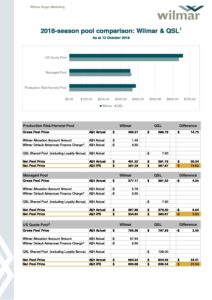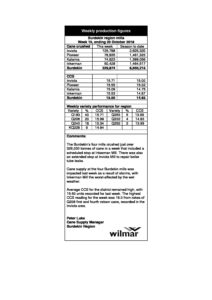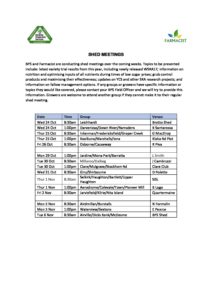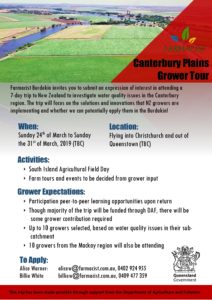Category: Industry Information
Miscellaneous information
BURDEKIN REGION MILL CRUSHING STATISTICS – BUDGET TO ACTUAL
SRA Media Release – Tissue Culture Orders
Deadline approaching for sugarcane tissue culture orders
Sugarcane growers and productivity services companies have until 15 November 2018 to place their orders for sugarcane tissue culture, if they are planning to use this technology for planting new crops in spring 2019.
Tissue culture is increasing in popularity due to its potential for managing plant diseases, and for allowing growers to access new varieties more quickly. 2018 was a record year for the technology, with over 76,000 plants ordered from Sugar Research Australia (SRA).
Tissue culture is a technique that grows planting material – in this case sugarcane – in a laboratory and nursery before being transferred to growers or productivity services for planting. These plants are then typically grown in small plots to bulk them out for more widespread commercial planting.
SRA Researcher, Ms Clair Bolton, said that growers and productivity services needed to place their orders by the deadline to allow sufficient time for the material to be prepared ahead of spring planting next year.
“SRA and productivity services encourage growers who are considering tissue culture to talk to their local productivity services organisation for local advice,” Ms Bolton said. “There are also information sheets available on the SRA website, as well as an online calculator that can help you work out how many plantlets you may need.”
Tissue culture has been recognised as an effective way of controlling diseases that are spread through planting material, including ratoon stunting disease, leaf scald, and Fiji leaf gall.
Sugar Services Proserpine Manager, Mr Peter Sutherland, said the Proserpine region had moved toward greater use of tissue culture and one eye sett material as part of a move to make it easy for growers to obtain new varieties quickly and replenish clean source material for their existing varieties.
He said that sourcing clean planting material – such as through tissue culture – was valuable for creating a strong foundation for productivity in the district.
SRA Annual General Meeting
This email is just a reminder that the SRA Annual General Meeting will be held at SRA, 50 Meiers Road, Indooroopilly, Qld on Thursday 25 October commencing at 2.00pm (Brisbane time) i.e. in two days.
All relevant information can be found in the link below
https://sugarresearch.com.au/sra-information/investor-information/
At this link you will find the
- AGM Notice of Meeting Booklet
- Proxy Form Group G 2018
- Proxy Form Group M 2018
|
Anthony Curro | Regional Coordinator (Burdekin) Mobile +61 484349868 | Office +61 7 4783 8602 Email [email protected] | Web sugarresearch.com.au | ABN 16 163 670 068 PO Box 387 | 30962 Bruce Highway | Brandon Q 4808 Australia |
Burdekin Production Report – Week 19
Reef Champion Awards Finalist announced – Reef Alliance
Proposed Change in the Composition of Water Authority Boards Section 598A(2) of the Water Act 2000
Proposed Change in the Composition of Water Authority Boards Section 598A(2)
of the Water Act 2000.
Good afternoon members,
Roadvale Water Board have organised a petition in relation to the Department of Natural Resources, Mines and Energy’s proposed change to the election procedure. If you would like to participate in the e-petition there is a link below. KCGO encourages members, family and friends to support petition in an effort to keep community control with continued election of directors by local water board’s ratepayers.
Petition against the proposed changes to Category 2 Water Boards has been approved by the Queensland Parliament.
“It has been proposed by the Palaszczuk Labor Government that the way in which Category 2 Water Boards are put in place is changed from an election process to a nomination procedure. This nomination procedure could potentially remove local voices, with local knowledge, by removing the election of directors by local water users, replacing democratic elections with a costly and complex nomination process where directors are subject ultimately to Ministerial appointment. Presently a number of Category 2 Authorities, including the Roadvale Water Board, are operated by a dedicated team of local board directors elected from within the community and contribute exponentially more than remuneration received.”
This petition is open to all Queensland residents and includes all Cat 2 Water Boards.
Click this link to open the E-Petition: https://www.parliament.qld.gov.au/work-of-assembly/petitions/petition-details?id=3021
This E-Petition closes on 29/10/2018.
Your support is appreciated.
Les Elphinstone
Manager KCGO
BPS & Farmacist – Shed Meeting Timetable
NZ Farmacist Tour
Ayr Data Driven Decisions Workshop
AYR DATA DRIVEN DECISIONS WORKSHOP
Are you a farmer wanting to understand what’s really happening on your farm? Why is collecting data important? What can you do with data?
Then come along to our free workshop for some simple tips and tools to manage data for better management decisions!
Practical Decisions – By discussing how to efficiently collect data and through demonstrating data collection instruments, we’ll help you understand how to incorporate data insights into your decision making process!
Improved Efficiency – Hear real-world case studies from producers outside your commodity. Learn about how they’ve realised potential and increased efficiency by using data to make decisions on their property. Case studies will include: Fertiliser Application, Asset Monitoring, Individual Animal Management and Farm Business Record Management.
Farm Ready Skills – This workshop will demonstrate how an increasingly Digital Environment affects reliable data collection, efficient use of resources and analysis of objectives to achieve conclusions supported by evidence and much more!
Facilitated by CQ University’s Research Fellow in Agri-Tech Education & Innovation Amy Cosby.
How to Attend
Date: 15th November 2018 Location: Ayr Anzac Memorial Club Time: 9.30am – 1.30pm
Register with Eventbrite or contact Diana Saunders on 07 3837 4726 or [email protected] by Friday 2nd November 2018.
ANY MEMBERS INTERESTED IN ATTENDING CAN SIMPLY PHONE OR EMAIL DIANA SAUNDERS





